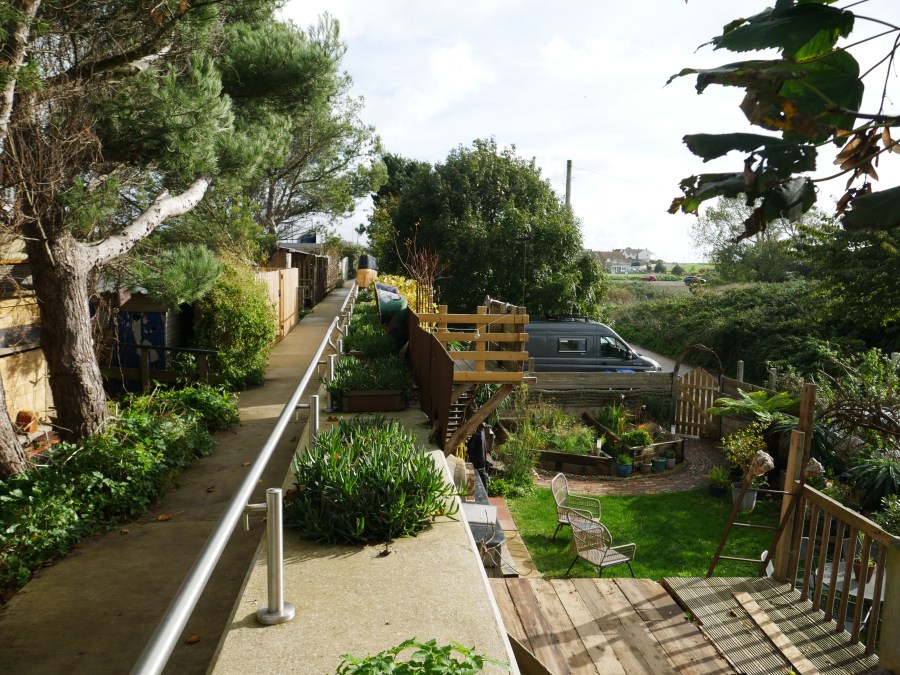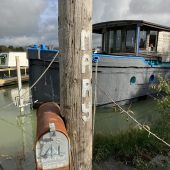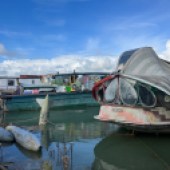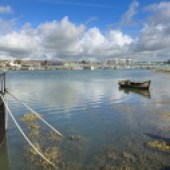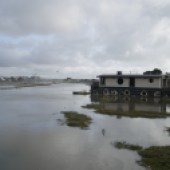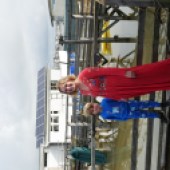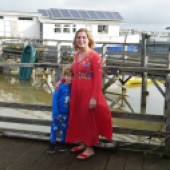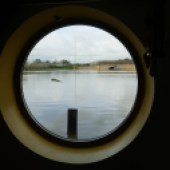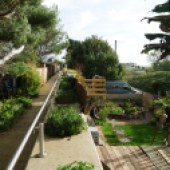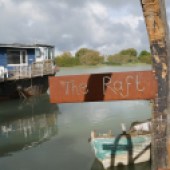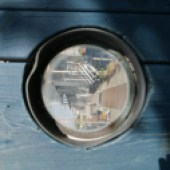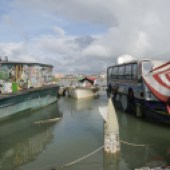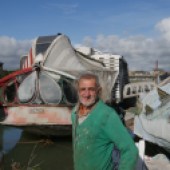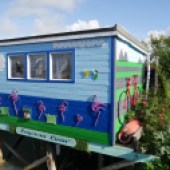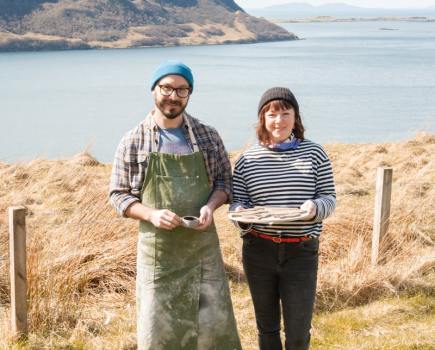The Adur estuary at Shoreham is home to a colourful houseboat community that offers an alternative lifestyle on the water.
Homes built of bricks and mortar aren’t the be-all and end-all. Certainly not for those who inhabit a string of striking houseboats moored on the seaward shore of the Adur estuary at Shoreham in West Sussex. If you’re seeking bland and boring, look elsewhere.
The three weirdest and wackiest floating residences incorporate a surprising array of re- or upcycled vehicles and appliances. The façade of one houseboat includes a green Reliant Robin alongside the side panel of a graffitied caravan and a bathtub repurposed as an unusual window (with taps).
Another has a defunct washing machine masquerading as a porthole window and, above, the shell of an old bus (complete with wheels), the windows of which offer a near-panoramic view across the water. Completing the unconventional trio is an extraordinary asymmetrical structure, half of which is shaped like an enormous fish with the words ‘Revolution’ emblazoned along its side.
The ichthyoid vessel and its two subversive shipmates are the handiwork of long-term houseboat dweller, and now Airbnb host, Hamish McKenzie. I come across him tinkering in his workshop inside the body of the fish. He invites me onboard and we cross a small pontoon to the neighbouring ‘bus’ where we settle down in front of an extraordinary window for a chat.
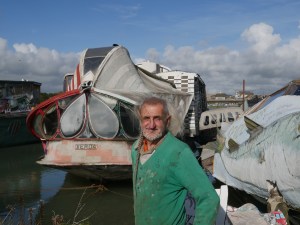
Anarchic boat builder Hamish McKenzie in front of the striking windows of houseboat Verda.
“I love this place to pieces,” he tells me. “I came here in 1986 and have seven boats, some rented out. Shoreham’s always had a boat-building community but it’s all changing. It was much more rough and ready when I arrived here.
“There were still quite a lot of ex-military boats from the Second World War here at the time. Those that have survived are getting more and more dilapidated. A few of mine are built on the base of former motor torpedo boats – they did 40 knots and were like the Spitfires of the Sea.”
These days, the boats are not going anywhere fast. Moored up, you’d be hard-pushed to recognise any sort of military hardware beneath the assorted paraphernalia of Hamish’s outlandish houseboat creations. However, the shell of a torpedo – sitting upright in the mud nearby and fully visible at low tide – is a powerful reminder of their provenance.
Hamish continues: “I’ve set myself the task of trying to save as many of these old military boats as I can. We are rapidly losing a lot of our houseboats, even the barges. These days, people are just building a floating base and then putting a house on top of it; they’re not actually houseboats at all. It’s quite sad to see the money moving in and the community becoming gentrified.”
Hamish studied 3-D design at Northbrook College in Worthing in the 1990s. He came up with a circular-square shape (squircle) that he’s used to great effect on the enormous bay window of the boat we’re chatting on.
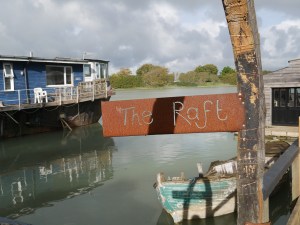
The Raft is one of the houseboats holidaymakers can rent.
“We live in a very linear, rectangular world,” Hamish tells me. “All our newbuild houses look the same. I’ve repurposed discarded items to create houseboats with different shapes because it gives me pleasure to live in them. With a boat, you don’t need planning permission or building regulations, so I don’t need to ask anyone’s permission. The only limit to what I can do is my ability and imagination.”
Hamish isn’t the only creative person in this small community. Strolling along the walkway from where the houseboats are accessed, I spot numerous notices advertising the services of artistic types including a signwriter and decorative artist and an artist working in stained glass.
Hamish’s neighbours may not have lived on the Adur for as long as he has, nor stamped their personality quite so vividly on their homes, but they share his love of a lifestyle influenced by the ebb and flow of the tides.
Esther Clarke moved here just before her five-year-old son, Arnie, was born. She says, “I love it. When the tide rises, the swans and ducks come up to our windows. I saw a kingfisher the other day and one came right to the window on Arnie’s birthday. We’re really lucky because we have this huge sky around us and these really beautiful round windows that perfectly capture the sunset. I feel really blessed to live here.”
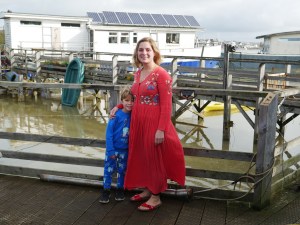
Esther Clarke’s son Arnie has grown up living on one of Shoreham’s houseboats.
These homes, sandwiched between the beach and the town, are so sought after that opportunities to live in this riverbank community come up only rarely. Esther was fortunate to have friends who have lived on the houseboats for twenty-odd years who put out the word that she was looking for somewhere to rent. A bijou ‘flat’ became available on the lower deck of a houseboat, beneath the main cabin, and Esther didn’t hesitate. She invites me into the compact but enchanting space she and Arnie call home.
Entering down a steep staircase, it’s like being in a caravan on the water, where every nook and cranny is put to good use and everything has its place. Arnie proudly shows me around, including his raised cabin bed that doubles as a play den in their shared bedroom. Esther tells me that although it’s a quirky and cosy place to live, no home comforts have been sacrificed; there’s underfloor heating, double glazing and even a mini corner bath.
Looking through the round windows reminds me of watching Playschool as a child, hearing the presenter say “Which window shall we look through today? Let’s look at the view through the ‘watery window’…” Esther seems to pick up on my reveries. “At first, I found the tides hard to get used to,” she says. “I’d wake up in the middle of the night to a gentle rocking motion and wonder what was going on, then realise that the water had lifted the boat. Initially, it was a curious sensation.”
As I take my leave and head up the stairs to the jetty, she adds, “Each boat has a different story, different quirks. When you come here and see all these unusual boats, you realise you don’t have to live in a square box if you don’t want to. You don’t have to stick with convention, and that’s what I love about living here.”
I can certainly see the appeal of a life that follows the gentle rhythm of the tides in a scenic location within walking distance of a bustling and historic coastal town. On the landward side of the towpath, many of the houseboats even have small sunken gardens that are as individual as the vessels they belong to. By embracing an alternative way of living, Esther, Hamish and their houseboat neighbours appear to have the best of it all.
HOLIDAY ON A HOUSEBOAT
Fancy holidaying on a houseboat? A number of Shoreham’s unique houseboats are available to book for those seeking an alternative Airbnb between the salt marsh and the sea. Whatever your taste in interiors, you’re bound to find something to suit.
For two people, check out mini houseboat Bunty, a converted 30-foot cabin cruiser or The Raft, a well-crafted vessel with a colourful interior, moored alongside the owners’ houseboat, Rebus Stone. For larger groups, there’s quirky Houseboat Dodge (sleeps five), the mid-century vibe of narrowboat Rhubarb and Custard (sleeps four) or Bimini, which has its own sauna and sleeps six guests.
Fancy your own experience living on a boat? Check out our best boat staycations.
Looking for the perfect holiday right at the water’s edge? Try out our selection of exclusive cruise trips around the British Isles here.

